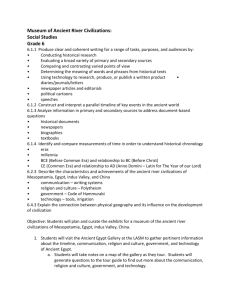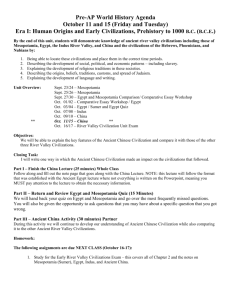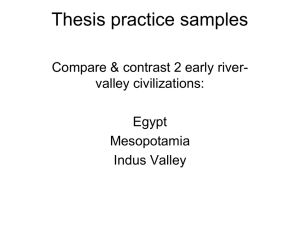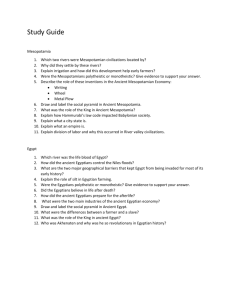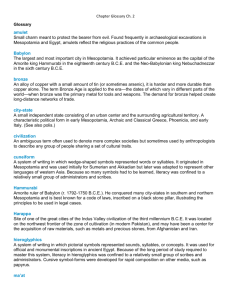The Compare and Contrast Essay
advertisement
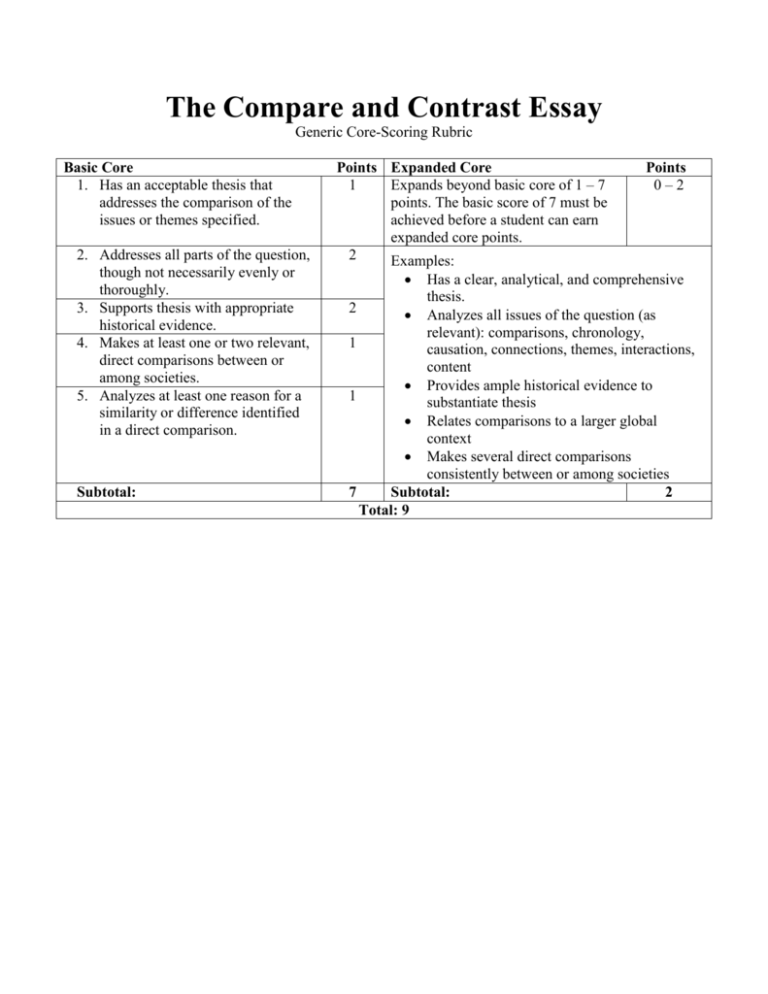
The Compare and Contrast Essay Generic Core-Scoring Rubric Basic Core 1. Has an acceptable thesis that addresses the comparison of the issues or themes specified. 2. Addresses all parts of the question, though not necessarily evenly or thoroughly. 3. Supports thesis with appropriate historical evidence. 4. Makes at least one or two relevant, direct comparisons between or among societies. 5. Analyzes at least one reason for a similarity or difference identified in a direct comparison. Subtotal: Points Expanded Core 1 Expands beyond basic core of 1 – 7 points. The basic score of 7 must be achieved before a student can earn expanded core points. 2 Examples: Points 0–2 Has a clear, analytical, and comprehensive thesis. 2 Analyzes all issues of the question (as relevant): comparisons, chronology, 1 causation, connections, themes, interactions, content Provides ample historical evidence to 1 substantiate thesis Relates comparisons to a larger global context Makes several direct comparisons consistently between or among societies 7 Subtotal: 2 Total: 9 Sample Comparison Essay Directions: Read and locate (circle, underline, highlight, etc.) all the compare and contrast words. Take note of the format of this well done compare/contrast essay. Confucius and Plato: A Few Really Good People What is the best way to create a strong society? Can people be led by moral example because they are basically good – or do they need a philosopher-king to help them control the evil within themselves? What is the best way to create a good society? History offers many answers. Hammurabi of Babylon, as we saw, believed in harsh laws, while Jesus of Nazareth saw love as the key. Most of us have ideas that fall somewhere in between. Given the many different answers to this basic question, it is striking how similar were many ideas of the ancient Chinese sage Confucius (Kung Fuzi, or “Master Kung,” 551 – 479 B.C.E.) and famous Greek philosopher Plato (427 – 347 B.C.E.). Both believed that a good society or state had to be led by men of superior virtue and wisdom. Both generally distrusted laws because they made people devious and merchants because they fostered greed. Neither favored democratic self-government, but both believed in the existence of absolute moral truth and in the possibility that humans could live in peace and harmony. Both focused attention on the individual, but neither believed in “individual rights” in the way that we use that phrase. Before we explain these similarities by saying that “great minds think alike,” we should note several important differences between these two philosophers. While both believed that only those who were already virtuous could create a well-ordered, peaceful political community or state, Confucius and his followers were convinced that all human beings were basically good, or could be nurtured to be so. Plato begged to differ; he thought most people were far too easily deceived by tyrants or greed. They needed to be controlled, either by their carefully educated “betters” or by laws. Naturally, these differing views on human nature resulted in different versions of the ideal government. Confucius emphasized human behavior in general, while Plato stressed the importance of the behavior of a carefully educated ruling class. It might be said that Confucius was more interested in the relationship of individuals within a community, while Plato was more interested in universal truths. The views of each have been widely studied and have affected the lives of millions over the centuries. Yet their insights, however universal in nature, also reflect the unique features of the world in which each lived. Source: Personalities and Problems: Interpretive Essays in World History by Ken Wolf Writing Structure for Comparison Essays Sample prompt: Compare and contrast the Aztecs and Incas. The Split—categories Body paragraph 1—political Body paragraph 2—economic Body paragraph 3—social (similarities and differences) (similarities and differences) (similarities and differences) Similarities and differences Body paragraph 1—similarities Political Economic Social Body paragraph 2—differences Political Economic Social * You may not find similarities and differences in all three categories. Lump Body paragraph 1—region 1 Political Economic Social Body paragraph 2—region 2 Political Economic Social When you write compare and contrast essays you must not just list the attributes of each topic. You must relate their similarities and differences to each other. When writing the second body paragraph you must refer to information in the first body paragraph. No matter which structure you choose, you must be sure to make direct comparisons. Useful Categories of Comparison SPEC Social, Political, Economical, Cultural SPRITE Social, Political, Religious, Intellectual, Technological, Economical PERSIA Political, Economical, Religious, Social, Intellectual, Artistic SPEEK Social, Political, Economical, Environmental, Knowledge SPEED Social, Political, Economical, Environmental, Demographic GRAPES Geographical, Religious, Artistic, Political, Economical, Social SPICE Social, Political, Intellectual, Cultural, Economical SCAPE Social, Cultural, Artistic, Political, Economical Chart: Compare and Contrast Two Civilizations Comparison Region/Event: ______________________________ ______________________________ Comparison Themes: ______________________ _____________________ _____________________ Thesis: 1st 1st Theme 2nd Theme Conclusion: Region or Event 2nd Region or Event Key Similarities and Differences Analyze one reason why each theme is similar or different Chart: Compare and Contrast Two Civilizations Comparison Region/Event: Comparison Themes: Mesopotamia and Egypt State Systems and Social Structures Thesis: For most of human history, people lived in relatively egalitarian societies and developed fairly simplistic forms of government. This all changed with the domestication of plants and animals. The development of agriculture allowed people to generate a food surplus for the first time, which in turn led to the creation of complex social and political systems found in river valley civilizations like those in the Middle East and Asia. While the civilizations of ancient Mesopotamia developed social structures that were very similar to those found in ancient Egypt, their political systems were very different. 1st Theme State Systems 1st Region or Event Mesopotamia 2nd Region or Event Egypt Tightly controlled city-states Ruled by powerful kings who controlled vast amounts of land Court systems and written laws (harsh punishments – Code of Hammurabi from Babylon) Rulers claimed authority came from the gods Strong connection between government and religion – rulers often helped assume responsibility for pleasing the gods and assisted priests with rituals Often warred with other city-states and outside invaders Political united state Strong connection between government and religion Pharaoh considered a living god Technically the pharaoh owned all of the land in Egypt Legal systems – courts and written laws Key Similarities and Differences Analyze one reason why each theme is similar or different Both rulers Physical controlled vast geography – amounts of land. Mesopotamia Egyptian was on an economy was open plain – more fully constantly controlled by dealt with the government invasions; than its this made it counterpart in difficult to Mesopotamia. unify Both developed Mesopotamia court systems into one state. and written law codes. Both Egypt and Mesopotamia participated in warfare to ensure a steady supply of slaves taken as prisoners of war during combat. 1st Region or Event Mesopotamia 2nd Theme Rigid social hierarchies Ruler at top, followed Social by priests and govt. Structures officials, skilled workers – scribes, engineers, artisans, etc. Most of the people were peasants – toward the bottom of the social pyramid Bottom rung occupied by slaves – differences between Sumerian and nonSumerian slaves Women often wore veils and were secluded in the home Conclusion: 2nd Region or Event Egypt Key Similarities and Differences Rigid social hierarchies Pharaoh at top, followed by other members of the royal family, priests and local govt. officials, skilled workers – scribes, engineers, artisans, etc. Most of the people were peasants – toward the bottom of the social pyramid Bottom rung occupied by slaves – could earn freedom but difficult to do so. Women had more legal rights – own their own property, run businesses, sue for divorce, serve as witnesses in court Love and romance? Poetry reveals greater degree of affection Both had strict social classes based on job specialization Both had patriarchal societies Women in Egypt were respected more – participated in public life more (but still expected to obey husband) Love poems in Egypt indicated some emotional attachment rarely seen between husband and wife in ancient civilizations Analyze one reason why each theme is similar or different Sample Essay: Putting It Together Question: Compare the political and social structures of two of the following: Mesopotamia, Egypt, Indus Valley, Shang Dynasty, and Mesoamerica and Andean South America. Thesis Statement: For most of human history, people lived in relatively egalitarian societies and developed fairly simplistic forms of government. This all changed with the domestication of plants and animals. The development of agriculture allowed people to generate a food surplus for the first time, which in turn led to the creation of complex social and political systems found in river valley civilizations like those in the Middle East and Asia. While the civilizations of ancient Mesopotamia developed social structures that were very similar to those found in ancient Egypt, their political systems were very different. Topic Sentence #1: While the rulers of ancient Mesopotamia and Egypt both created political systems that allowed them to exercise total control over their subjects, the organization of these systems was totally different. Fact #1 Ancient Mesopotamia was composed of tightly organized independent city-states that were ruled by kings who claimed divine authority, while Ancient Egypt was a politically united state ruled by a king who was considered to be a living god. Fact #2 Both Mesopotamian and Egyptian rulers controlled vast amounts of land. Fact #3 While both governments were actively involved in their respective economies, the Egyptian economy was more fully controlled by the government than its counterpart in Mesopotamia. Fact #4 Governments in Mesopotamian city-states and ancient Egypt developed court systems and written law codes. The Babylonian king Hammurabi created perhaps the world’s first written law code in an attempt to set general standards of justice. Fact #5 Both Egypt and Mesopotamia participated in warfare to ensure a steady supply of slaves taken as prisoners of war during combat. Fact #6 Analysis. Because of its physical geography, Egypt was less prone to invasion and was therefore able to maintain a unified state, unlike Mesopotamia, which stretched across an open plain and was in a constant state of warfare. Topic Sentence #2: The generation of a food surplus allowed all early civilizations to develop a system of job specialization, which in turn led to the creation of similar rigidly defined social hierarchies like those found in Egypt and Mesopotamia. Fact #1 Both civilizations developed rigid social hierarchies with a strong political ruler at the top, followed by a ruling elite composed of political advisors and other government officials, priestly class, and a professional class of merchants and other skilled workers and craftsmen. Most of the people formed a peasant class of manual laborers and farmers. Fact #2 Because of the difficult associated with learning written languages like cuneiform and hieroglyphics, scribes held considerably high positions in Mesopotamia and ancient Egypt. Fact #3 While slaves occupied the bottom spot in the social hierarchy, they were often able to earn money and even buy their freedom. Topic Sentence #3: Civilizations everywhere undermined the earlier equal relationships of men and men. While women in Egyptian towns and villages lived in a patriarchal society like those found in Mesopotamia, they were significantly better off than women in any other early civilization. Fact #1 Women in Mesopotamia often wore veils and were secluded in private homes, away from the prying eyes of strangers on the street. Fact #2 Women in Egypt had several legal rights that women in other early agricultural societies lacked. They could own their own property, run their businesses, and initiate divorce proceedings. Fact #3 Evidence exists that indicates many marriages in ancient Egypt may have been based, at least in part, on romance, in addition to other considerations. Examples of love letters and poems, like The Flower Song, illustrate strong feelings of love on the part of husbands towards their wives. Conclusion: The rise of agriculture profoundly changed the human experience all over the world. All early river valley civilizations developed complex social, political, and religious structures that were unknown before the Neolithic Revolution. Despite these common features, environmental conditions helped create sharp differences in the various civilizations that emerged in the Middle East during the preclassical era.

